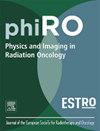基于知识的模型,自动多等中心全骨髓和淋巴细胞辐照计划跨越标准和大病人解剖
IF 3.3
Q2 ONCOLOGY
引用次数: 0
摘要
背景与目的全骨髓和淋巴细胞放射治疗(TMLI)计划具有挑战性。本研究评估了基于知识(KB)的TMLI模型是否可以通过全自动或半自动优化实现临床可接受的剂量分布,以及单一模型是否适用于不同的患者解剖结构。材料与方法选择51例VMAT-TMLI患者。使用标准配置(5个身体等中心点)治疗的30例患者训练KB模型。验证包括两个队列:10名标准患者和11名解剖结构较大的患者使用单独的手臂等中心点(4个身体和2个手臂等中心点)进行治疗。研究了两种规划方法:全自动(AutoKB)和手动调整的KB (HybridKB),由没有TMLI经验的规划人员进行。使用配对t检验对KB计划与临床计划(CPs)进行评估。结果KB模型降低了主要危险器官(OARs)的平均剂量。对于标准配置,CP、AutoKB和HybridKB的平均OAR剂量分别为71%±2%、66%±2%和66%±2% (p <;0.01)。对于体型较大的患者,相应值分别为75%±3%、69%±2%和68%±2% (p <;0.01)。规划目标体积的D2%在AutoKB中增加,达到122%±2% (p <;0.001),而标准配置的CP为117%±3%,126%±2% (p <;0.001) vs.武器配置的CP为117%±3%。HybridKB与CPs相当。结论单一KB模型可以有效地规划多等心TMLI,包括手臂需要单独等心的解剖。全自动KB提供了次优剂量分布。人工改进的知识库减少了对计划人员的依赖并提高了计划质量。本文章由计算机程序翻译,如有差异,请以英文原文为准。
Knowledge-based model for automated multi-isocenter total marrow and lymphoid irradiation planning across standard and large patient anatomies
Background and purpose
Total marrow and lymphoid irradiation (TMLI) planning is challenging. This study evaluates whether a knowledge-based (KB) model for TMLI delivered using volumetric modulated arc therapy (VMAT) can achieve clinically acceptable dose distributions through fully or semi-automated optimization and whether a single model is effective across varying patient anatomies.
Materials and methods
Fifty-one consecutive VMAT-TMLI patients were selected. A KB model was trained using 30 patients treated with standard configurations (5 body isocenters). Validation included two cohorts: 10 standard patients and 11 patients with a larger anatomy treated using separate isocenters for the arms (4 body and 2 arms isocenters). Two planning approaches were explored: fully automated (AutoKB), and KB with manual adjustments (HybridKB) by a planner with no prior experience in TMLI. KB plans were evaluated against clinical plans (CPs) using paired t-tests.
Results
The KB model reduced mean doses to major organs-at-risk (OARs). For standard configurations, mean OAR doses were 71% ± 2%, 66% ± 2%, and 66% ± 2% for CP, AutoKB, and HybridKB (both p < 0.01). For larger patients, the corresponding values were 75% ± 3%, 69% ± 2%, and 68% ± 2% (both p < 0.01). D2% of the planning target volume increased in AutoKB, reaching 122% ± 2% (p < 0.001) vs. 117% ± 3% in CP for standard configurations, and 126% ± 2% (p < 0.001) vs. 117% ± 3% in CP for arms configurations. HybridKB was on par with CPs.
Conclusions
A single KB model enabled effective planning for multi-isocenter TMLI, including anatomies requiring separate isocenters for the arms. Fully automated KB provided suboptimal dose distributions. KB with manual refinements reduced planner dependence and improved plan quality.
求助全文
通过发布文献求助,成功后即可免费获取论文全文。
去求助
来源期刊

Physics and Imaging in Radiation Oncology
Physics and Astronomy-Radiation
CiteScore
5.30
自引率
18.90%
发文量
93
审稿时长
6 weeks
 求助内容:
求助内容: 应助结果提醒方式:
应助结果提醒方式:


